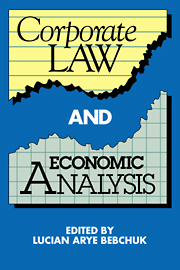Book contents
- Frontmatter
- Contents
- List of contributors
- Introduction
- Acknowledgments
- 1 Mergers, acquisitions, and leveraged buyouts: an efficiency assessment
- 2 Discounted share prices as a source of acquisition gains
- 3 Ties that bond: dual class common stock and the problem of shareholder choice
- 4 Property rights in assets and resistance to tender offers
- 5 A new approach to corporate reorganizations
- 6 The corporate contract
- 7 The state competition debate in corporate law
- 8 The positive role of tax law in corporate and capital markets
- 9 Ownership of the firm
- Index
6 - The corporate contract
Published online by Cambridge University Press: 15 December 2009
- Frontmatter
- Contents
- List of contributors
- Introduction
- Acknowledgments
- 1 Mergers, acquisitions, and leveraged buyouts: an efficiency assessment
- 2 Discounted share prices as a source of acquisition gains
- 3 Ties that bond: dual class common stock and the problem of shareholder choice
- 4 Property rights in assets and resistance to tender offers
- 5 A new approach to corporate reorganizations
- 6 The corporate contract
- 7 The state competition debate in corporate law
- 8 The positive role of tax law in corporate and capital markets
- 9 Ownership of the firm
- Index
Summary
For a long time public and academic discussion of corporations has started from the premise that managers have “control” and use this to exploit investors, customers, or both. The usual prescription is some form of public control. This may take the form of regulation of the firm's output and prices. It may take the form of regulation of the securities markets. It may take the form of intervention through corporate law, which establishes minimum voting rules and restricts how managers can treat the firm and the investors.
The argument is simple. In most substantial corporations – firms with investment instruments freely traded, which we call public corporations – each investor has a small stake compared with the size of the venture. The investor is therefore “powerless.” The managers, on the other hand, know how the business is running and can conceal from investors information about the firm and their own activities. As a result the managers can divert income to themselves, stealing and mismanaging at the same time. Diversion and sloth may be subtle, but it exists. Even when it does not, the potential for misconduct remains. Only some form of regulation can protect investors. And the limit on regulation is to be found not in principles of free contracting – for the corporate charter is at best a contract of adhesion by which the managers call all the shots – but in a concern that regulation not go “too far ”.
- Type
- Chapter
- Information
- Corporate Law and Economic Analysis , pp. 182 - 215Publisher: Cambridge University PressPrint publication year: 1990
- 42
- Cited by

